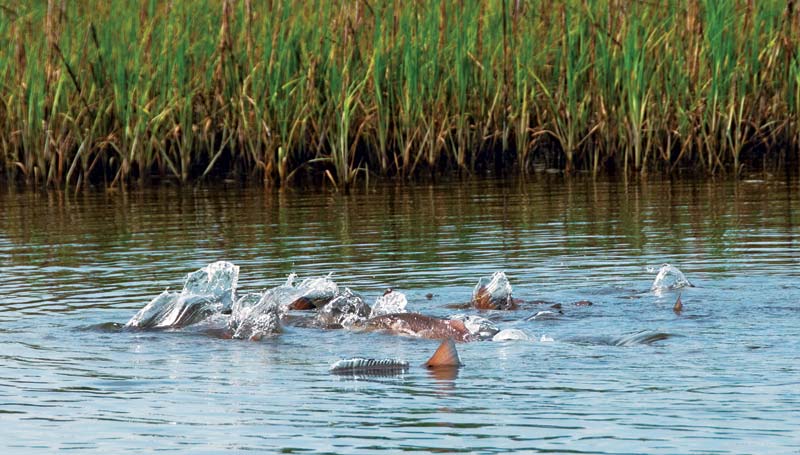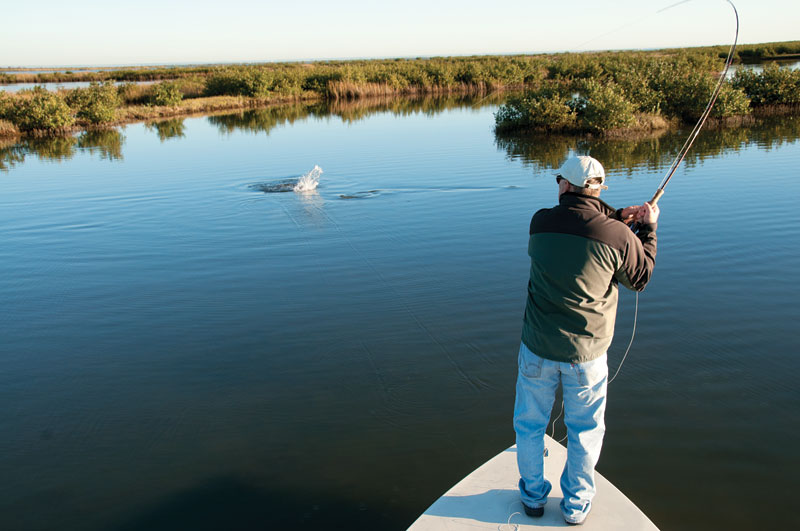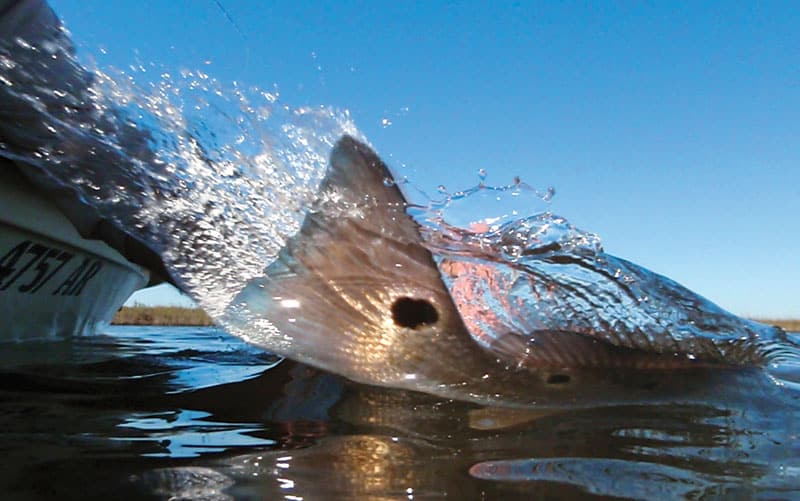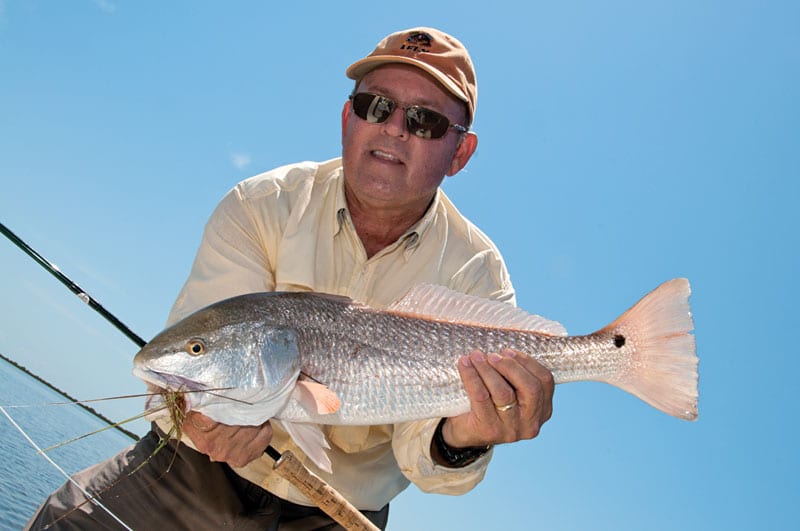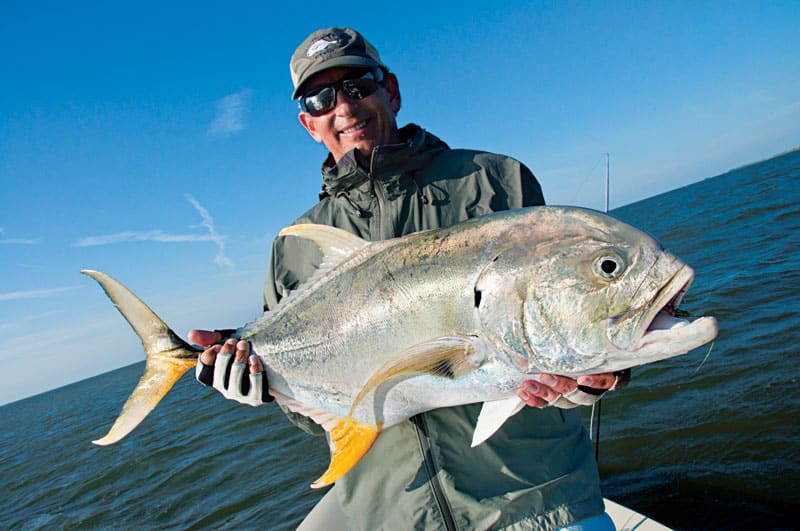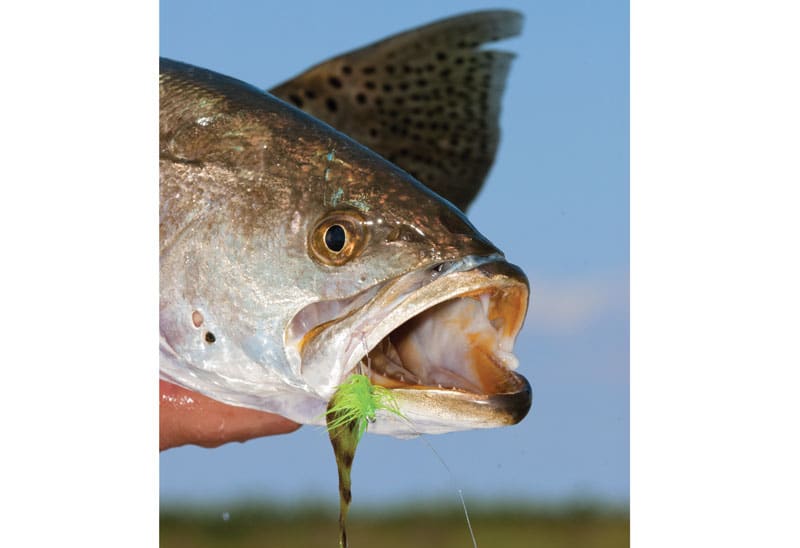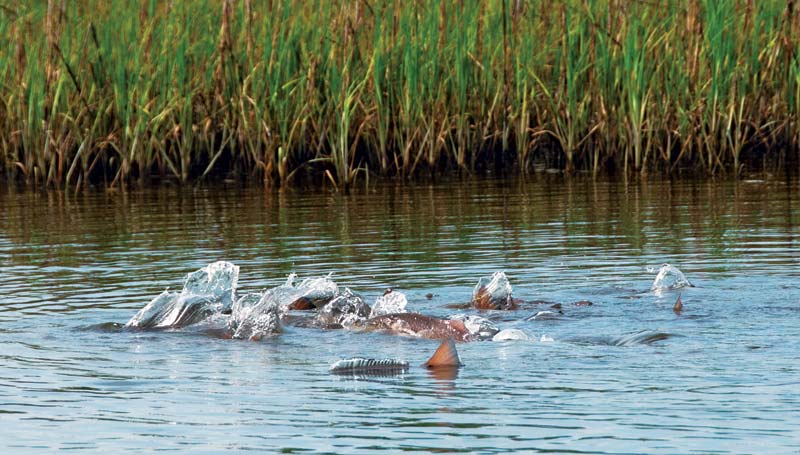
texas on fly
Fly-fishing guides who call Texas home await one special event each year. You can only speculate upon when exactly it will occur, even with a keen eye placed on the Weather Channel. Then one day it happens — you wake up to subtle changes. The dog’s-breath humidity you’ve grown accustomed to during the summer months has been replaced by dry air, light north winds and a cloudless blue sky. In Texas, waking up to this indicates good things to come.
On this long-awaited day, everything is confirmed as redfish feed with reckless abandon while blue-winged teal buzz across the bay and through the marsh low to the water, giving heart attacks to unsuspecting souls standing atop poling platforms. Even more evidence is presented on the boat ride back, when schools of large, ravaging jack crevalle can be seen sending frantic menhaden into the air. Autumn is no longer months out but only weeks or even days away, and you know that your life as a fly-angler is about to get good.
The Right Choice
Most years, the event I speak of occurs in late August or early September, but this past season, the change was a little later than what I would consider normal and not near as subtle. Friend and fellow guide Capt. Tom Horbey and I already had one day of a six-day, two-boat booking down, with five more to go. The previous day had not been particularly kind to either one of us, as we had to spend the majority of it fighting high winds, high water and cloudy skies. We returned to the dock not unsuccessful but not holding our heads high either.
The following morning, we awoke to a ripping 25-plus mph wind and a decision — to go or not to go. If it had been spring and the wind had been coming out of the east or the south, it might have been a difficult decision, but it was after the autumnal equinox and the wind was coming straight from the north, making our choice a no-brainer. We were both fishing out of the same ramp and knew, with the wind blowing as hard as it was, the areas to fish would be limited, so we had a strategy session to make sure we did not try to target the same areas, and we were off.
When my client, Art Hinkley, and I pulled up to the shoreline we intended to fish, it was apparent the wind was going to make things difficult, but I still had faith in my judgment. It wasn’t long before the first couple of opportunities at redfish came and went, but as predicted, the fish were there and seemed to be on the feed. We approached a third group of fish, and Hinkley made a presentation that resulted in an immediate hookup. Unable to stake off the boat in the high wind, I held position, waiting for the fight to play out, and then quickly jumped down to land and release the fish.
Just as I settled back on the platform, I noticed something peculiar in the distance that looked an awful lot like a tornado. Unable to determine exactly what it was, I jumped down and grabbed my binoculars. With the optical aid, I was able to determine that what I thought was a twister was actually acres and acres of pelican diving into what appeared to be a whirlpool tub the size of a football field. The water was frothing and boiling, with bait flying from the water in every direction. “Jacks! Art! Grab the 10-weight!” I yelled.
After about an hour, Hinkley had bested two of the brutes and I was getting ready to set us up for the third when he informed me ever so politely, “I think I’m ready to go back to fishing for redfish.” Truthfully, I couldn’t blame him. A pair of 20-plus-pound jacks can and will wear anyone down, especially when the fish have access to deeper water, where they can do their dirty work. By this time, the wind had settled down to all of about 3 mph, so I fought my way back to the shoreline, where we finished up and put together one heck of a day of redfishing. Upon returning to the dock, we learned that Horbey and his crew had similar results. Horbey and I both agreed our long-awaited favorite season had begun.
Favorable Conditions
The next morning, we awoke to clear skies and light to moderate winds. The rest of the week, we were rewarded with near-perfect conditions for sight-casting to reds, as well as a few more opportunities at jacks. In fact, the most memorable of the days happened when Hinkley’s wife, Cindy, joined us on the last day of the trip. It was her birthday, and her husband wanted to share the experience with her. Her gift: She landed five beautiful redfish.
The rest of the fall and early winter was a blur for me. I was able to get on the water most days and was rewarded with nothing short of exceptional fishing. I’m sure we had an off day or two, but honestly, I’m having a difficult time remembering them. And I’m not the only one. My good friends and peers Chuck Naiser, Ethan Wells and Horbey (we all fish the Coastal Bend area of Texas) cannot seem to drop the subject of last autumn and cannot wait for this coming one. Strangely, it seems to be the same story every year.
The days following the autumnal equinox are always special, although every year the days leading up to and just after it seem different. Some years that first little front with accompanying light north winds comes and knocks the surf flat in mid- to late August. And when it does, the beachfront is where I’ll most likely be. Surf-run trout, ladyfish, bull reds and a fair chance at running into a tarpon are all realistic expectations. A front like that came through several years ago, and we were rewarded with two slams that day (two redfish, two tarpon and more trout than we could shake a stick at). We’ve not repeated that day since, but it will always be burned into my memory as one of finest days of Texas fishing ever.
After the Storms
Then, of course, are the years that Mother Nature reminds us who’s the boss and sends a mess our way in the form of tropical storms, hurricanes or both. But rest assured, once these nasty systems are gone, and hopefully easily forgotten, the tropical weather leaves in its wake some of the most spectacular fishing you could imagine. This was blatantly obvious on a day I shared my skiff with a gentleman by the name of Mike Wilson shortly after Hurricane Ike pummeled the upper Texas coast.
Wilson, who owns the Houston-based fly shop I Fly, purchased a donated trip to join legendary angler and television personality Flip Pallot on my skiff for two days of redfishing. Late in the summer, with fingers crossed, we decided on a couple of days in the early fall, hoping that Mother Nature would be kind. Fortunately, she was. The area I fish most often was on the clean side of Hurricane Ike, and the only effects were some minor wind damage and a little high water that receded nearly as fast as it rose, giving the bay a much-needed flush.
The night before our fishing was to begin, Wilson, Pallot and I sat down at the Falcon Point Lodge for a sinful dinner and then enjoyed “just a few” adult beverages on the patio overlooking the bay. The whole time, I kept staring at the weather forecast on my phone, hoping the weatherman was going to get it right for a change. And then it happened — the wind shifted to the north, and the skies cleared. To call the next two days of fishing amazing would be a vast understatement. Tailing fish, cruising fish and crawling fish — they were everywhere, and they were hungry. It’s only an estimate, but I’m comfortable saying we boated around 30 fish each day. Few would argue it gets any better than that.
Since that trip, Wilson has become a regular on my skiff; however, it always seems to be from September through early December — I wonder why?
Nothing Better
This past fall, after a great day on the water, I gave Naiser a call to see how he had done a little farther down the coast in Rockport. His results were equally impressive. He quickly shared that Wilson had fished with him and that it was about as perfect as perfect could get. “It’s always great to see those thin, wispy clouds hanging in a clear blue sky and ibis flying low to the water,” he said. “You know as well as I do, when you see that, fall is here, baby!”
After listening to Naiser tell his version of the day, I was inspired to get Wilson’s side of the story, so I gave him a call. He was just as fired up and went on and on about how the fish were jumping on the fly from two feet away.
Recently, Wilson called to lock down some dates for this coming fall, and we got to talking. I asked why he did not fish more in the spring or summer. “Well, you simply cannot beat fly-fishing in Texas in the fall,” he replied. I can’t argue with him on that.
Planning a Trip
Rods: A 7-weight for redfish and a 10- to 11-weight for jacks and tarpon.
Reels: High-quality reels with drags that can handle successive runs from powerful fish.
Lines: Floating lines for most redfish scenarios and clear-tip intermediate lines for the 11-weight, as well as spare spools with floating lines for jacks on the surface.
Flies: Brown Slider (below), light-brown Clousers and spoon flies are popular fall redfish and trout patterns. When jacks are feeding, they will eat just about anything, but tarpon flies work really well.
Guides
Chuck Naiser
www.chucknaiser.com
361-729-9314
Capt. Tom Horbey
www.captaintomhorbey.com
361-983-2263
Ethan Wells
www.wellsoutfitters.com
361-548-3952
Shops
Fishing Tackle Unlimited
www.fishingtackleunlimited.com
281-481-6838
I Fly
www.ifly.org
713-993-9981
